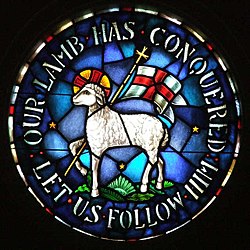
Moravian Church
Protestant Christian denomination dating back to the 15th century / From Wikipedia, the free encyclopedia
Dear Wikiwand AI, let's keep it short by simply answering these key questions:
Can you list the top facts and stats about Moravian Church?
Summarize this article for a 10 year old
The Moravian Church, or the Moravian Brethren (Czech: Moravská církev or Moravští bratři), formally the Unitas Fratrum (Latin: "Unity of the Brethren"),[3][4][5] is one of the oldest Protestant denominations in Christianity, dating back to the Bohemian Reformation of the 15th century and the Unity of the Brethren (Czech: Jednota bratrská) founded in the Kingdom of Bohemia, sixty years before Luther's Reformation.
| Unity of the Brethren | |
|---|---|
| Latin: Unitas Fratrum | |
 A stained glass emblem of Agnus Dei at Trinity Moravian Church in Winston-Salem, North Carolina | |
| Classification | Proto-Protestant |
| Orientation | Hussite (Bohemian) with Pietist Lutheran influences |
| Founder | Followers of Jan Hus and Petr Chelčický; later renewed by Nicolaus Ludwig Zinzendorf, Christian David and David Nitschmann |
| Origin | 1457 / 1722 Bohemia / Herrnhut, Saxony |
| Congregations | 1,000+[1] |
| Number of followers | 1,112,120 (2016)[2] |
| Official website | unitasfratrum |
The church's heritage can be traced to 1457 and the Lands of the Bohemian Crown, which included Bohemia, Moravia, Silesia, and previously the Hussite movement against several practices and doctrines of the Catholic Church. Its name is derived from exiles who fled from Moravia to Saxony in 1722 to escape the Counter-Reformation, establishing the Christian community of Herrnhut; hence it is also known in German as the [Herrnhuter] Brüdergemeine [sic][6] ("Unity of Brethren [of Herrnhut]").[7]
The modern Unitas Fratrum has about one million members worldwide,[1] continuing their tradition of missionary work, such as in the Americas and Africa, that is reflected in their broad global distribution.[8] Moravians continue many of the same practices established in the 18th century, including placing a high value on a personal conversion to Christ, called the New Birth, and piety, good works, evangelism, including the establishment of missions, Christian pacifism, ecumenism, and music.[8][9]
The Moravian Church's emblem is the Lamb of God (Agnus Dei) with the flag of victory, surrounded by the Latin inscription "Vicit agnus noster, eum sequamur" ('Our Lamb has conquered; let us follow Him').